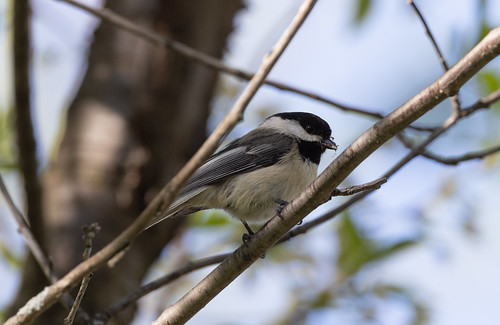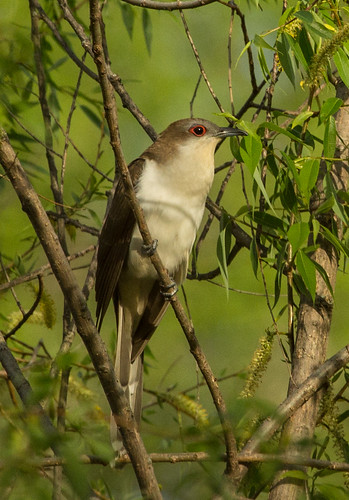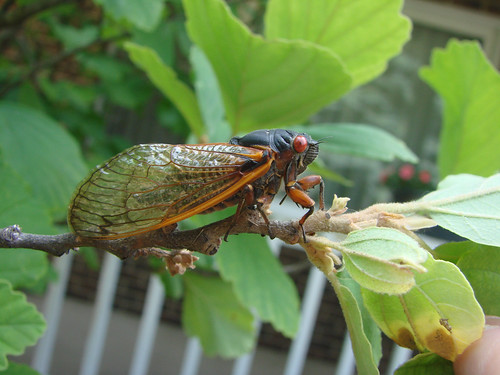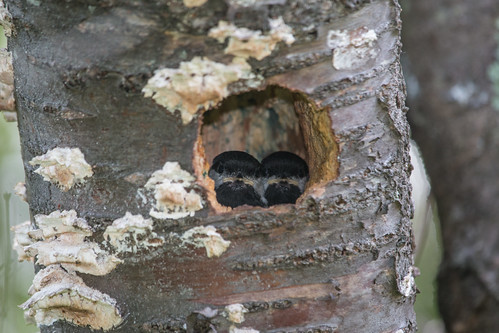Now that my backyard chickadees are in a frenzy finding tiny insects, especially larvae, to feed their nestlings, I’ve been thrilled to notice just how much food my backyard affords them. The adults stop by my home office window a few times a day to take a few mealworms, but those apparently simply provide quick meals for parents on the go. They gobble them down in the spruce tree by my window, and then head back to the other trees to search for tinier, more tender offerings for their tiny, tender offspring. They spend much of their hunting time in my crabapple tree, and then head to the nest with several insects in their beak. They dive into the nest hole directly most of the time, so my photographs at the nest don’t show what they’re carrying. But en route, they usually stop briefly in my still-living cherry tree, where I’ve grabbed a few photos showing the insect food.
I’ve never considered using insecticides in my yard, even before my rehab experiences when I took care of one tragic Blue Jay fledgling that was found with horrible neurological problems by a woman whose yard was sandwiched on either side and behind by lawns treated by one of the national lawn services. A lot of people think they’re only getting rid of the dandelions, and don’t consider how bad herbicides can be. And those lawn applications invariably include dangerous insecticides as well, on the off-chance that a given lawn has cutworms. No pesticides are “approved” by the EPA—getting registered does not require them to pass any lab or field testing to ensure that they can’t harm birds. And even if some pesticides were safer than others, what those national companies use are proprietary secrets anyway, so their customers have no way of evaluating their safety.
Oddly enough, this week I’ve heard of two different situations, one up here in northern Minnesota and the other in Washington, D.C., in which Facebook posters have blithely told others to solve an insect problem with insecticides. The Northland one was when someone posted a photo of a cluster of native forest tent caterpillars in a fruit tree. Immediately, people were posting about how ugly they are, and how they should spray the entire tree, or set the cluster on fire, before the caterpillars travel to other trees. The defoliation that native caterpillars sometimes cause is mainly an issue of aesthetics—trees, especially native species, usually survive because they evolved with those native species of insects, which tend to be cyclic, giving the trees plenty of time to recover between outbreaks.
Meanwhile, those very caterpillars are a critical food source for Black-billed Cuckoos, whose populations trace the same cyclical rise and fall as their prey. Bacillus thuringiensis, or “Bt,” an alternative to chemical pesticides, is a bacterial agent that kills young caterpillars and is not toxic to birds, but it’s indiscriminate about which caterpillars it kills—all lepidopteran larvae are vulnerable, meaning someone spraying my apple tree to defend against one kind of caterpillar would eliminate virtually all the food my chickadees are depending on. The complexity of both natural cycles and large communities of plants and animals is more than many people want to consider.
The other situation in which I’ve heard people clamoring for insecticides is where cicadas are emerging this year. I was in Elmhurst, Illinois, the epicenter of a 17-year cicada emergence in 2007, and I can attest to how ungodly loud they were. I was visiting my sister, who lived in a house close enough to O’Hare that all the doors and windows have to meet a soundproof code. We’d be talking inside and one of my nieces would walk in, and the moment the door opened it was impossible to hear anything but the roar of the cicadas. I’ll certainly admit that it was more fun to visit during the emergence than to live day by day through it, but it’s a unique part of nature, lasts for a few weeks and is over, and provides abundant food for birds. And other than the noise, cicadas don’t hurt anything. And it’s impossible to eradicate them without hurting a lot of other wildlife.
Anyway, this year’s cicada emergence in the Washington D.C. area coincides with a disturbing outbreak of birds dying from some sort of neurological problems that include blindness. No one knows what is causing this—it’s never been seen before, and so far no one has been able to figure out if the cause is bacterial, viral, or exposure to a toxin. Some people are afraid that the birds are succumbing because so many people are using pesticides to deal with the cicadas. Birds being picked up dead and dying seem mostly to include grackles, Blue Jays, mockingbirds, and bluebirds, all of which are species that feed on cicadas and might indeed have been poisoned from pesticides killing cicadas.
In an age when people don’t know how to deal with the fellow human beings in our own communities, I guess I shouldn’t be surprised that we have trouble dealing with our fellow creatures of other species, including those who have lived in our communities for millennia before we entered the scene. But it’s tragic that the only species on the planet whose members include rocket scientists have so much trouble understanding the simplest concepts of ecology—that what we do to any species has a ripple effect on a great many other species including our own, and that keeping those other species healthy is good for us, too. The very first day of my very first ecology class, my professor, Bob Hinkle, wrote a simple sentence on the board: “Diversity equals stability.” Whether we’re talking about ecological or social science, that simple principle has stood up over time.




